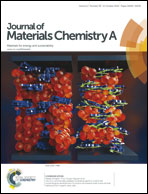Electrostatic shield effect: an effective way to suppress dissolution of polysulfide anions in lithium–sulfur battery
Abstract
Sulfur has a very high theoretical specific capacity of 1672 mA h g−1 when used in lithium–sulfur batteries. However, the particularly rapid capacity reduction owing to the dissolution of intermediate polysulfide anions into the electrolyte still hinders practical application. In this respect, we report a novel core–shell structured sulfur–poly(sodium p-styrenesulfonate) (S@PSS) composite cathode material with a sulfur content as high as 93 wt% for lithium–sulfur batteries, which is the highest sulfur content disclosed in the literature. Due to the effective transport of lithium cations while blocking polysulfide anions by common ion Coulombic repulsion of the negatively charged –SO3− groups in the PSS protective layer, the S@PSS composite cathode exhibits a high initial specific capacity of 1159 mA h g−1 at a 0.1 C rate, and retains a stable discharge capacity of 972 mA h g−1 after 70 cycles and 845 mA h g−1 after 120 cycles with a high Coulombic efficiency of over 99%. To our knowledge, this new methodology for lithium–sulfur cathodes has not been reported so far; the initial specific capacity is the highest value calculated based on total composite mass, which has not been disclosed in the literature.


 Please wait while we load your content...
Please wait while we load your content...